“The iPhone 7 is a fantastic phone, but we recommend the 7 Plus (or waiting for the iPhone 8).”
- Dunkable, water resistant
- Fantastic camera
- Improved battery life
- Gets regular software updates and fixes
- Stereo speakers
- No headphone jack
- Lacks 2x optical zoom like the 7 Plus
- Jet black version prone to scratches
No phone comes without a pain point or two, as we’ll find out in our iPhone 7 review. Apple has often succeeded in irritating people with its new iPhone. The iPhone 5 annoyed buyers with the Lightning port and cable. The iPhone 5S was a tiny phone among huge Android devices. The iPhone 6 brought us #bendgate. The iPhone 6S underwhelmed buyers with a lack of noticeable new design or features.
What has the iPhone 7 done? It has no headphone jack.
None of those other flaws have managed to hobble the iPhone’s popularity. But the latest — a step backward in functionality — has skeptics wondering if the iPhone’s supremacy is waning.
It has no audio jack
Though Motorola beat it to the punch, the iPhone 7 will likely go down in history as the device that killed the 100-year-old audio jack. Some of us, like DT audio guru Caleb Denison, are understandably upset about the death of the headphone jack on iPhone 7. We’re torn on the subject, as we’ll demonstrate throughout this iPhone 7 review.
Wires are awful. They get twisted. They get knotted. They get caught on chairs and yank your headphones off your ears. But for all these flaws, an open headphone standard means you can use one pair of headphones — even a 30-year-old-pair — with any audio device in the whole world.
With the iPhone 7, Apple has eradicated the headphone jack and instead wants you to go wireless or use the Lightning charge port for audio. The phone even includes a pair of Lightning EarPods and a headphone jack adapter, so you can keep using your old headphones, but will future iPhones come with the adapter?
In testing, we found the change somewhat annoying, but mostly benign. The Lightning EarPods sound fine (if they work at all, see below) and we’ve spent most of our time using the Lightning adapter with our favorite earbuds. Audio fidelity seems unaffected. What Apple really wants is for you to buy its wireless Bluetooth AirPods, which we do like even though they look a little strange.
But hey, it is waterproof
Commenters may get angry at us for using the word “waterproof” in our Apple iPhone 7 review, since the iPhone is technically “water resistant” with an IP67 rating. But if you can submerge it in a meter of water for up to 30 minutes … that’s waterproof to us. No, don’t take it swimming on purpose, but there is peace of mind in knowing that it won’t shut down if someone pushes you into the pool or it starts to rain. We submerged our iPhone 7 and 7 Plus many times already, and they enjoy taking a good bath. Popular repair site iFixit put one in a fish tank for more than seven hours and it survived.
Water resistance means you have one less thing to worry about. We wish it was drop resistant, too. Maybe that will come next year.
The rest of the design is similar to the iPhone 6 and 6S. Apple managed to get rid of two antenna lines along the back of the aluminum phone, and it now comes in two fancy new colors: black and jet black. We love the matte black, and the jet black is gorgeous, though high maintenance. It picks up a lot of fingerprints, and the glossy finish does collects small scratches fairly easily. You may be better off with a silver, gold, rose gold, or regular black iPhone 7.
Two speakers — one on the bottom and one up top — mean you can watch movies with stereo sound. It sounds considerably better than older iPhones and many other phones, except for HTC devices, which always have amazing sound.
There is one last design change that will affect your day-to-day life a little. Apple has replaced the physical Home button and Touch ID fingerprint sensor with a haptic button that mimics the sensation of clicking with vibration. The change likely has to do with waterproofing and some other silly reasons, but after several days with the 7, we like the new Home button more. It takes a day or two to get used to the new feel, but it is ever so slightly more responsive, making Touch ID more useful.
iOS is still highly competitive, and gets updates
iOS 10 doesn’t shake things up immensely, but Apple has added some smart, common-sense features that we cover in depth in our iOS 10 review. Lockscreen notifications have significantly improved, though they still lag behind the wonderfully swipe-able Android notifications. iMessage also has a host of small improvements that add a lot of joy to chatting.
We have submerged our 7 and 7 Plus many times already and they enjoy taking a good bath.
The fact that Apple guarantees software updates for about four years, with regular security updates every couple months, is a colossal reason to choose an iPhone over any Android phone. (Except Pixel devices, which share a similar blessing from Google.) Most Android phones — including from big-name producers like LG, Samsung, and Sony — are lucky to get a couple updates in the two or three years you own them. Those companies don’t put out enough security and feature updates themselves, and let wireless carriers control who gets updates, which often leaves users in the dust.
Besides denying users awesome new features this year, Android’s update problem leaves hundreds of millions of Android phones vulnerable to attacks. We’re hoping Google addresses it soon.
It’s a very powerful phone
The iPhone 7 is almost as powerful as the larger iPhone 7 Plus, but not quite. It has only 2GB of RAM, compared to the 3GB in the Plus, and its 4.7-inch IPS LCD screen, though vibrant, is only 750 × 1,334 pixels — less than the 1080p screen on the Plus.
Aside from that, it has the same A10 ‘Fusion’ quad-core processor in it. The novel idea (at least, for an iPhone) here is that two of the cores are high efficiency, and will use less battery, but the other two, more powerful, cores are ready and waiting whenever you want to boot up a video game or do something more taxing. Apple claims the new chipset improves graphics capabilities by 50 percent compared to the A9 chip in the iPhone 6S.
In 3DMark and Geekbench 4 benchmark tests, the iPhone 7 outperformed the iPhone 6S by a significant margin, and outshined the iPad Pro and Pro 9.7 in every test but one. That’s remarkable, considering Apple is selling the iPad Pro as a PC replacement. It also handily outperformed the Galaxy S7, LG G5, and Huawei P9 in our tests, though we don’t detail this in our Apple iPhone 7 review.
When it comes to storage, the cheapest iPhone 7 ($650) has 32GB of internal storage, which should get you through a year or two of usage if you don’t take too many photos or install too many apps. We recommend that you pony up for the 128GB unit for an extra $100. It will take all the pressure off of storage management for you, and a little peace of mind is worth the price, in our opinion.
The camera falls short of fabulous
The iPhone 7 camera is noticeably better than the 6S if you’re in low light conditions, and if you’re coming from an iPhone 6, you’re in for a treat. Against competition like the LG V20 and Samsung Galaxy S8 series, we still prefer the iPhone camera overall, but it’s a tight race. Apple tends to capture colors and scenes in a more natural light, while Android competitors like to oversaturate colors. But to repeat: The Galaxy S8, the LG G6, and the Huawei P10 all have amazing cameras that are absolutely on the level with the standard iPhone 7’s 12-megapixel rear camera and 7-megapixel selfie cam. The aperture on the rear shooter has been increased to f/1.8, and it gains optical image stabilization (OIS) this year, which is fantastic. You can record 4K 30fps videos with ease on this phone.
Like all smartphone cameras, the iPhone still hasn’t nailed how to take shots of people in the dark if there’s a light source near them. Either the background looks good, or you do. If you like to use the flash, though, the iPhone 7 and 7 Plus have a better flash that Apple claims will offer 50 percent more light. We thought it looked a little better than usual, but no flash still looks better than a shot with flash. At night, we do think the Galaxy S8 often produces slightly better shots than the standard iPhone 7, though it’s a close race.
The iPhone 7 Plus is a different, much more epic, story. It has a second 12-megapixel camera on it, which gives it 2× optical zoom, and a neat DSLR-like bokeh effect.
Improved battery life
We’re impressed with the iPhone 7’s battery life, which gives at least 12 hours of solid use — two more than the iPhone 6S. The iPhone 7 battery is 1,960mAh, up from 1,715mAh in that model, which probably explains most of the extra life. Our old iPhone 6S tended to end the day at about 30 percent when it was new (after one year, it’s at 10 percent), and the iPhone 7 ended the day at about 44 percent battery life when it was new.
After nearly a year of continuous use, our iPhone 7 is showing the typical signs of battery fatigue. If we use it heavily during a day, it can easily run out of juice by 8 or 9 p.m., so we’ve found ourselves recharging it more often during the day. This is disappointing, but sadly normal for a smaller smartphone.
Whether it’s new or old, it still needs charging at least once a day, which puts it in the same league as most other devices these days.
A few weird problems from our iPhone 7 review
We purchased an iPhone 7 on launch day, and encountered a couple strange defects. Apple claims it has no other reports of these issues, and we haven’t read any reports of any online, but we wanted to make you aware.
- The SIM tray broke: When we used a paperclip to pop open the Nano SIM card tray and put in our card, the tray wouldn’t budge. After some pressing really hard, the paperclip slipped and actually tore off a tiny section of the tray. This is likely because of the complex new internal mechanism that operates the tray, and the water seal around it.
- Our EarPods didn’t work right: They started randomly cutting out on the first day we began using them, and now when we plug them in, sometimes the phone doesn’t even realize headphones are in at all, and just plays off the speakers. Other times, it will play, but cut out if the connector gets jostled at all. It now happens too regularly and frequently to use the pods at all. To fix this, we bought a new pair of EarPods, though Apple would likely replace them if you complain about the problem quickly.
These problems were anecdotal, Apple agreed to investigate, and neither turned out to be widespread problems. Therefore they haven’t been factored into the overall score.
Warranty information and customer service
The iPhone 7 comes with a one-year limited warranty that covers manufacturing defects. You cannot return an iPhone if the battery goes bad slowly, or its outer coating gets worn or scratched due to use, and sadly, water damage is not yet covered either. You can read the full warranty here.
AppleCare+ will extend the standard warranty to two years for $100, and cover you if you break the phone by dropping it, at least partially. Instead of $100+ for a new screen, AppleCare+ users only pay $30. Other damage is $100.
Outside of its programs, Apple’s customer service, especially in its many stores, is better than service offered by other phone makers. Its agents are usually very helpful. If you don’t live near an Apple Store, the company also offers live chats on its website.
Price, model, and availability
The Apple iPhone 7 is available in Apple retail stores and the online store, plus all major carriers, and through many retail outlets including Best Buy and Amazon. Apple sells versions for AT&T, T-Mobile, Sprint, and Verizon in its online store, along with an unlocked, SIM-free model. If you can, purchase it without a contract. This gives you more freedom to select the right network and plan for you, and makes it easier to sell the phone later on.
Choose between black, silver, gold, rose gold, or a jet black finish. Alternatively, go for the very good-looking special edition Product (Red) model, which is only available with 128GB or 256GB storage space. A 32GB iPhone 7 costs $650, the 128GB is $750, and the 256GB is $850. Apple also operates its own upgrade program, with prices starting at $32.41 per month, and the chance to change your phone over for a new model after a set period of time.
Unsure about which iPhone to buy? We recommend the larger iPhone 7 Plus. Make sure it’s 128GB+, not jet black (it scratches easy and is a fingerprint magnet), and a Sprint or Verizon model while you’re at it. If you buy Sprint or Verizon, your phone will work on any carrier. If you buy an AT&T/T-Mobile model, it will not work on Sprint or Verizon. This is good if you intend to sell it down the road, but also good in case you decide to switch carriers.
Our Take
You’ll want to pay out a little more for the larger and more capable iPhone 7 Plus, but that doesn’t make the iPhone 7 a bad phone. It’s still water resistant, powerful, has a strong camera, and receives all-important software updates on a regular basis. Even if you normally prefer a small screen, give the 7 Plus a try before settling on the 4.7-inch iPhone 7.
Is there a better alternative?
We consider the iPhone 7 Plus a better alternative to the iPhone 7, due to the excellent dual-lens camera and longer battery life. If you’re not already deep inside Apple’s ecosystem, and are considering an Android device instead, the best choice would be to select a Google Pixel, or better still, a Pixel XL.
Google treats these phones in a similar way to Apple and the iPhone, meaning the phones receive regular software updates, ensuring security and feature sets are always up to date. It may sound like a little thing, but security is very important, and protecting against the latest malware or recently discovered vulnerability is essential.
The iPhone 7 will be replaced in the near future, and unless you have to buy a new phone now, we’d say wait and see what the iPhone 7S, or the iPhone X, brings. The latest phone is usually a better alternative to any predecessor. No official date is known for the release of the next iPhone yet, but traditionally it’s in September or October.
How long will it last?
The iPhone 7 is made from metal and glass, and therefore not overly durable. Like most other premium smartphones, it really does need a good case to protect the finish, and in the event of a fall. The water resistance is a big benefit, and will help the phone last longer.
Any software update released during the iPhone 7’s lifetime will work with the device, and updates released after two years may work as well. You can probably expect about four years of regular updates, with new functionality added on a yearly basis. An iPhone 7 will have no problem lasting two years if you treat it well, and could well extend beyond that.
Should you buy it?
No, buy an iPhone 7 Plus. We have one of the most in-depth reviews you’re going to find on it, and it’s a fantastic phone. Yes, its lack of a headphone jack is frustrating at times, but the water resistance, fast processor, and dual rear cameras with 2× optical zoom make up for it. While the iPhone 7 is almost identical to the 7 Plus, and also excellent, it lacks the extra camera and 2× optical zoom. It also has worse battery life. Yes, the iPhone 7 is cheaper and smaller than the Plus (which will make some of you happy), and also has a camera that’s as good as any Android phone we’ve used, but the 7 Plus is a far nicer device, despite its daunting size.
There is very little about the standard iPhone 7 that is worth upgrading from an iPhone 6S, or even a 6 that still runs well, unless you absolutely need to upgrade or tend to go swimming with your phone. It looks almost the same, and you should milk your headphone jack while you have it. Additionally, Apple will launch the replacements to the iPhone 7 and 7 Plus sometime before the end of 2017, potentially alongside a special iPhone X model, and we’d wait and see what’s on offer there before jumping in and buying now.
If you’re coming from an Android, don’t buy a new phone unless you really need a new device. But Apple’s customer service and regular software updates are a good reason to consider an iPhone when the time comes, even though they’re expensive and do have a few annoying quirks, like no headphone jack.












